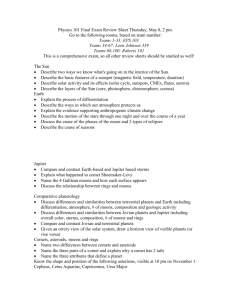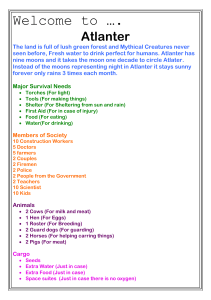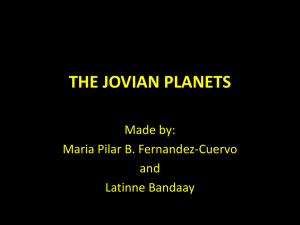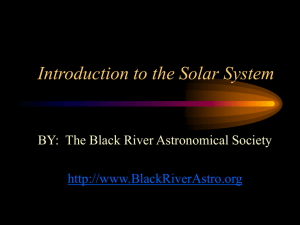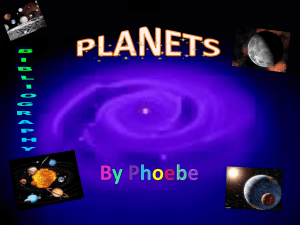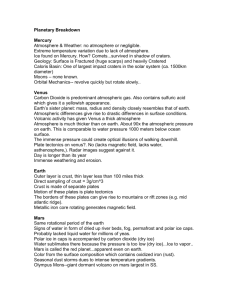class14
advertisement
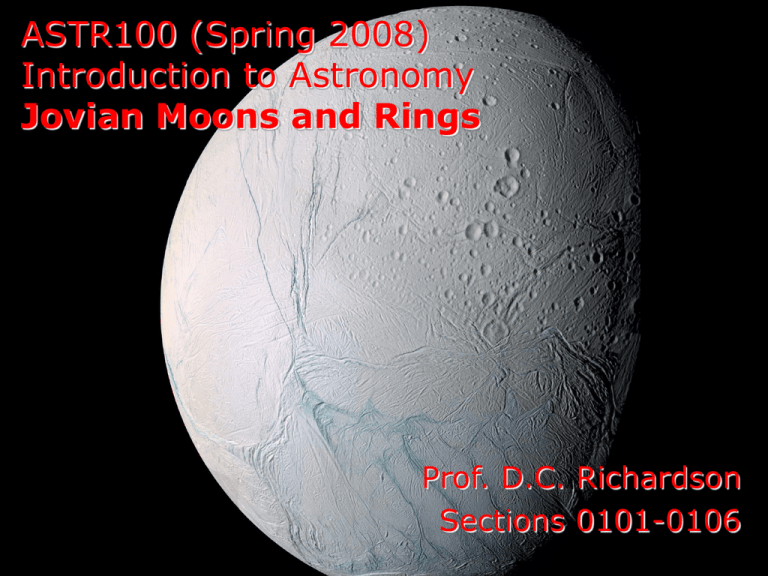
ASTR100 (Spring 2008) Introduction to Astronomy Jovian Moons and Rings Prof. D.C. Richardson Sections 0101-0106 What kind of moons orbit the jovian planets? Sizes of Moons Small moons (diameter < 300 km) No geological activity. Medium-sized moons (300–1,500 km) Geological activity in past. Large moons (> 1,500 km) May have ongoing geological activity. Medium and Large Moons Enough self-gravity to be spherical. Have substantial amounts of ice. Formed in orbit around jovian planets. Circular orbits in same direction as planet rotation. Small Moons Far more numerous than the medium and large moons. Not enough gravity to be spherical: “potato-shaped.” Hyperion! (Small Moon of Saturn) Why are Jupiter’s Galilean moons geologically active? Io’s Volcanic Activity Io is the most volcanically active body in the solar system, but why? Io’s Volcanic Activity Volcanic eruptions continue to change Io’s surface. Tidal Heating Io is squished and stretched as it orbits Jupiter. But why is its orbit so elliptical? Orbital Resonances Every 7 days, these 3 moons line up. The tugs add up over time, making all 3 orbits elliptical. Europa’s Ocean: Waterworld? Tidal stresses crack Europa’s surface ice Tidal stresses crack Europa’s surface ice Tidal flexing closes crack, grinds up ice. Tidal flexing opens crack, leaving two ridges. Europa’s interior also warmed by tidal heating Ganymede Largest moon in the solar system. Clear evidence of geological activity. Tidal heating plus heat from radioactive decay? Callisto “Classic” cratered iceball. No tidal heating—no orbital resonances. But it has a magnetic field!? Thin, salty, subsurface ocean? What geological activity do we see on Titan and other moons? Titan’s Atmosphere Titan is the only moon in the solar system that has a thick atmosphere. It consists mostly of nitrogen, with some argon, methane, and ethane. Titan’s Surface The Huygens probe provided a first look at Titan’s surface in early 2005. It has liquid methane and “rocks” made of ice. Titan’s “Lakes” Radar imaging of Titan’s surface has revealed dark, smooth regions that may be lakes of liquid methane. Medium Moons of Saturn Almost all show evidence of past volcanism and/or tectonics. Ongoing Activity on Enceladus Fountains of ice particles and water vapor from the surface of Enceladus indicate that geological activity is ongoing. Medium Moons of Uranus Varying amounts of geological activity occur. Moon Miranda has large tectonic features and few craters (episode of tidal heating in the past?). Neptune’s Moon Triton Similar to Pluto, but larger. Evidence of past geological activity. Why are jovian planet moons more geologically active than small rocky planets? Rocky Planets vs. Icy Moons Rock melts at higher temperatures. Only large rocky planets have enough heat for activity. Ice melts at lower temperatures. Tidal heating can melt internal ice, driving activity. What are Saturn’s rings like? What are Saturn’s rings like? They are made up of numerous, tiny individual particles. They orbit over Saturn’s equator. They are very thin. Earth-based view Spacecraft view QuickTime™ and a YUV420 codec decompressor are needed to see this picture. Artist’s conception of a close-up view One of my simulations! Gap Moons Some small moons create gaps within rings. More Cassini Pictures… Effect of Viewing Angle QuickTime™ and a YUV420 codec decompressor are needed to see this picture. Why do the jovian planets have rings? Jovian Ring Systems All four jovian planets have ring systems. Saturn’s rings have the largest, brightest particles. Why do the jovian planets have rings? They formed from dust created in impacts on moons orbiting those planets. How do we know? Rings aren’t leftover from planet formation—the particles are too small to have survived this long. There must be a continuous replacement of tiny particles. The most likely source is impacts with the jovian moons. Ring Formation Jovian planets all have rings because they possess many small moons close-in. Impacts on these moons are random. Saturn’s incredible rings may be an “accident” of our time.
